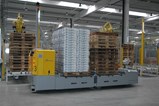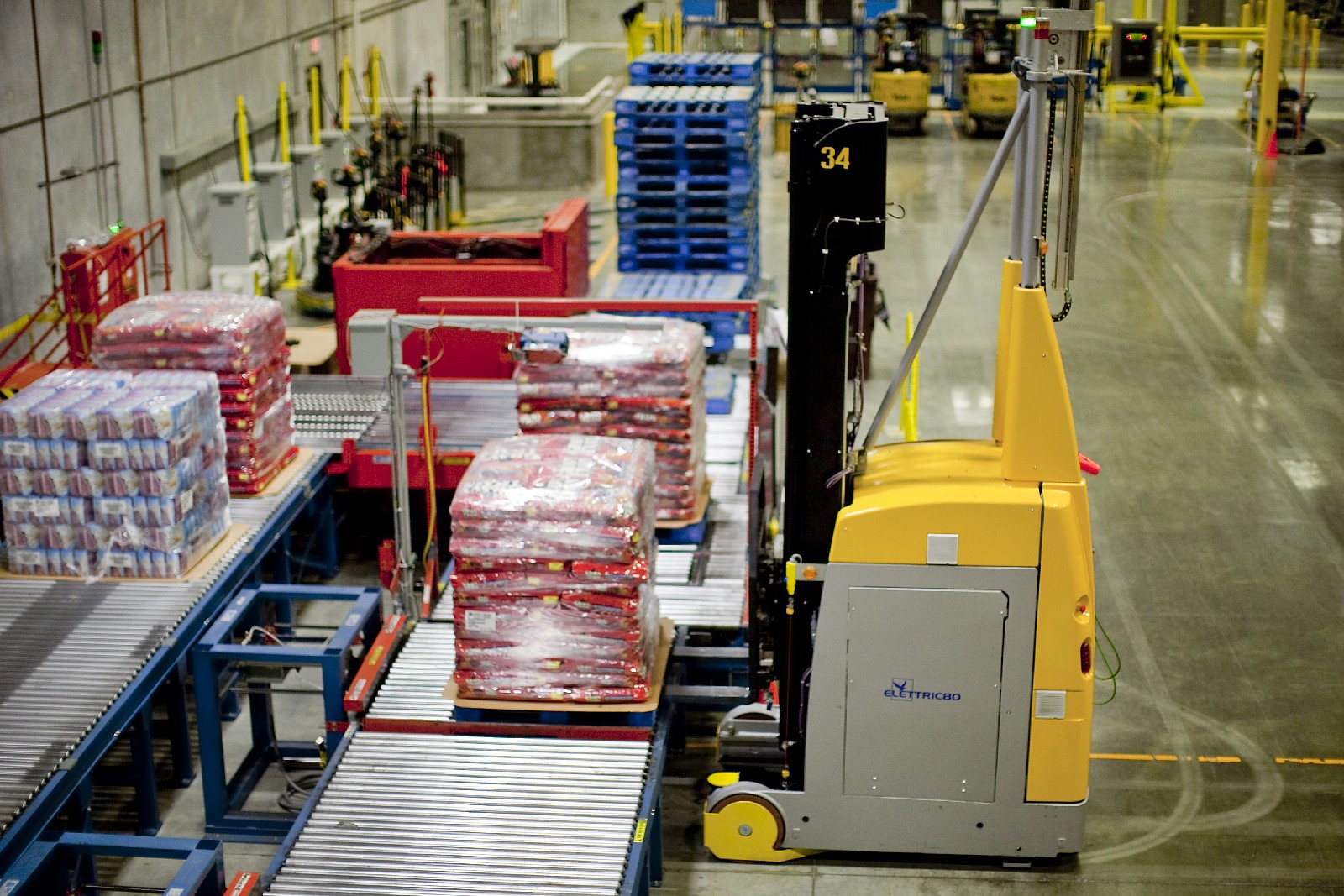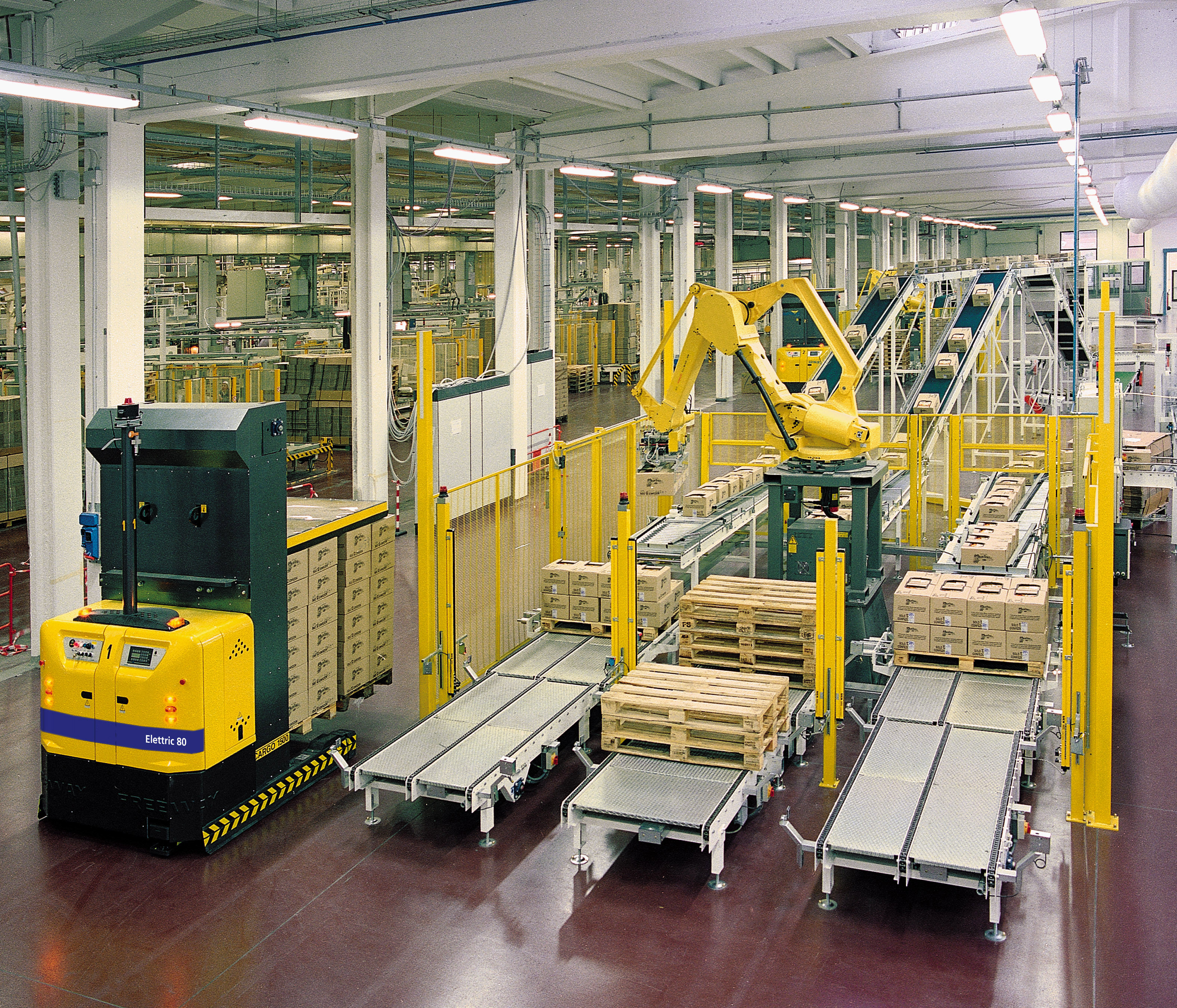Optimizing Efficiency With End-Of-Line Pallet Handling In Food Processing

By Jim McMahon
Unique with its integration of laser guided vehicles connecting islands of automation for robotic case palletizing, stretch-wrapping, pallet labeling and transport to the warehouse without the use of conveyors, Freeway, from Elettric 80, provides increased flexibility, reduced energy consumption, decreased labor cost and a lower total cost of ownership compared to conventional pallet handling systems – effectively redefining end-of-line pallet handling efficiency in food processing plants that manage a high volume of SKUs with high throughput requirements.
Many high-volume food processing plants are facing a growing logistics challenge – the need to package, store and ship an increased number of product SKUs to arrive at retailers, and their distribution centers, on schedule with a near zero tolerance of error. Sometimes comprising thousands of different SKUs and in a growing assortment of package types, these products need to cased, palletized, stretchwrapped, labeled and transported to the warehouse, or for outbound shipping, with a very high level of efficiency to optimize labor usage and minimize operational costs.
The numbers of different food products with their varied primary and secondary packaging is growing continually, and becoming increasingly difficult for food processors to maintain a high level of efficiency in managing their end-of-line pallet building and pallet movement into storage or shipment, using conventional conveyor-based automated systems.
Whatever the food product – canned or frozen foods, baked goods, or chilled meat and dairy products – the need for preparing and transporting end-of-line pallet loads with high throughput efficiency, precise product tracking and near zero product damage is of critical importance. This need is further emphasized by the impact of rising labor costs, increasingly stricter safety regulations, and the necessity to maintain acceptable food industry standards for cleanliness. Fast, efficient and accurate packaging and shipping are necessary for a strong competitive advantage in today’s demanding food market.
Inefficiencies with End-of-Line Pallet Handling Systems Most high-throughput food processors have advanced their filling and primary packaging equipment to embrace highly efficient operations, and downstream have equipped their warehouses with automated storage and retrieval systems (ASRS), automated guided vehicles (AGVs) and picking systems to improve throughput. But between these two operations, many food manufacturers are plagued with end-of-line pallet building and pallet transport systems that are inefficient.
Most conventional end-of-line pallet handling is based on conveyors linking carton packers with palletizers, stretchwrappers and labelers, then with the warehouse or shipping, supported by manually-operated forklift trucks.
Pallet conveyors are limited in their fixed configurations. Once set, it is unlikely that they can be easily moved to accommodate changing throughput requirements. Additionally, they limit free and available space for maneuvering and load staging in the end-of-line environment.
Because pallet conveyors tend to be highly fixed, they are susceptible to downtime because of malfunction, repairs and maintenance, which will impact the line if any of these occur while production is in operation.
In food processing plants, sanitation is always a factor. Although, end-of-line pallet handling conveyors may not be located in areas of the plant where food is directly being processed, product spillage is a concern.
When it does happen, throughput is slowed and can even stop the line. Many manufacturers have their pallet conveyors rated for wash-down or heavy wash-down as a better guarantee to recover the line in the event of a product spillage.
One of the major causes of food product damage, misdirected orders and indeed facility damage in food plants is from manually-operated forklift trucks moving pallet loads through the end-of-line and warehouse operations.
This is nowhere more evident than in the handling of chilled and frozen food products, which pose definite challenges for food processors that desire to have facilities operating at a high level of efficiency.
Maintaining a high throughput rate along with fulfillment accuracy at -18.4° F is a much more difficult and costly task than in ambient temperatures.
Chilled and sub-zero facilities have a higher incidence of product damage and wrong item fulfillment which have negative impacts on production and profits.
Not surprisingly, personnel turnover in chilled and cold facilities is also higher than in ambient temperatures. While the temperature in these facilities is cold enough to maintain food product safety, it creates an extreme environment with difficult working conditions for personnel, increased safety issues, and personnel recruitment and retention problems.
Today, a producer of food products needs to track and identify each pallet – where it came from, where it was stored, what the temperature was in storage, and other critical data to keep track of its perishable inventory and ensure its product integrity. End-of-line pallet handling with manual forklift trucks leaves open the possibility of human error, and with many manufacturers is cause for the biggest error points in its shipping.
To stay competitive, food producers need to implement end-of-line pallet handling solutions that address these issues. Solutions that will accommodate ambient, chilled and deep-freeze operating environments, and that will have the flexibility to adjust to throughput changes.
 A Better Solution for End-of-Line Pallet Handling
A Better Solution for End-of-Line Pallet Handling
An ideal end-of-line pallet handling solution for food manufacturers would encompass fully-automated robotic palletizing equipment, coupled with a flexible and mobile pallet transport system, linked to upstream processes and ERP, as well as downstream warehouse and shipping with a real-time load tracking and verification capability. In effect, an efficient pallet building and movement system capable of smoothly integrating various automated end-of-line processes.
Such an end-of-line pallet handling and transport solution has been designed, and is being used by hundreds of companies throughout the world.
It is called the Freeway Solution, manufactured by Elettric 80, who is now providing the system to the North American market.
Freeway is the world’s first fully integrated end-of-line solution combining robotic palletizers, laser-guided vehicles, label equipment, product tracking software and a PC-based monitoring system.
The Freeway system is based on a system-integrated concept. Robotic palletizing cells handle goods and optimize pallet loads at the end of the production line. LGVs transport the pallets to high-speed stretch-wrapping and labeling equipment, and then to storage, or staging on the floor to await shipping. No transport conveyors or manual forklift trucks are used.
The fully-automated systems are adaptable and completely integrated. Its flexibility makes it ideally suitable to accommodate the layout and design of any food processing plant.
Smart Laser Guided Vehicles
A range of pallet load transport tasks within the end-of-line environment can be automated and handled efficiently with Freeway’s LGVs. These LGVs achieve a uniform flow of product without rush and noise, and with a high degree of safety for the goods carried, workers and the operational environment.
The LGV system comprises one or more vehicles that move around predetermined routes to perform transport functions as directed by a stationary control system. They are equipped with navigation systems, based on laser guidance, which allows the LGVs to be free roaming within the end-of-line system layout.
The latest generation of Freeway LGVs can lift pallets up to 36 feet high for positioning in racked storage or floor staging. This reduces the rack damage caused by forklift trucks. It also reduces energy costs as the LGVs can operate in an un-lit environment.
The LGVs can reach speeds of up to five feet per-second and can carry multiple full pallets at a time. For food processing facilities, they are an ideal asset for moving ambient temperature, chilled and frozen products in unit loads.
The laser guided vehicles are quite sophisticated, combining multiple systems to ensure reliability and efficiency, including energy, safety, fork/load handling and guidance and control systems.
The Freeway LGVs are outfitted with an obstacle detection system to detect anything in their path in sufficient time so that the units can slow down and stop if necessary. Once the path is clear, the LGVs will automatically continue their trip. The system is designed to handle high-volume pallet movements on a 24/7/365 operation.
Fully Integrated System Controls Optimize AGVs with Pallet Handling Robotics 
The smooth functioning of the Freeway LGVs is dependent on its controls system, which has the task of coordinating the orders received from the plant’s process system or ERP, and warehouse and shipping, and then directing the work for the laser-guided vehicles.
The Freeway controls provide real-time management of the system’s operation, including management information, load prioritization, load status, productivity statistics and reports, and workload analysis.
It allows associated functions to be automated, such as case stacking in the robotic palletizers, empty pallet inspection and delivery, finished pallet transport, finished pallet stretch-wrapping, finished pallet labeling, and finished pallet transport to storage or shipping. It is a Windows and SQL database architecture that is able to uniquely operate within a single platform.
The positional status is continuously being updated through the controls system, at least once per second, regarding such factors as whether it is loaded or unloaded, emergency stopped or soft stopped, operating in manual mode and battery level. A simulation module simulates the LGVs in the system. An HMI graphical interface gives the operator a graphical overview of the LGV locations in the system and monitors each in real-time.
The system’s controls monitor and guide the complete end-of-line pallet handling process, and optimize the use of different machine groups in relation to the logistic process and production management. Its modular design is tailored to meet the needs of specific food processing plants and their existing processes and ERP, such as containing software for scheduling, routing, monitoring and visualization of the complete end-of-line process for a particular plant. The food sectors’ special requirements for hygiene, safety and data tracking are leading components of this system design.
A New Benchmark in Automated End-of-Line Pallet Handling
An end-of-line solution in food processing plants must go beyond typical measurements of cases-per-minute. It must include availability and efficiency, product damage, finished pallet throughput, finished pallet integrity throughout the supply chain, product traceability, staffing and maintenance.
Consideration must not only be given to case preparation and case stacking onto a pallet, but must also include empty pallet inspection and delivery, finished pallet handling, pallet stretch-wrapping, pallet labeling and pallet transport and storage.
With the emergence of Elettric 80’s Freeway, a new level of flexibility and efficiency above and beyond the capabilities of conventional automated palletizing and pallet transport systems has been realized for end-of-line production. For food processors, improved productivity, increased accuracy, better safety, less maintenance and reduced labor requirements are but some of the key benefits of this system.
Freeway has enabled a truly comprehensive and integrated end-of-line, system-wide pallet handling solution, which has set a new benchmark for streamlining end-of-line efficiency in high-volume/SKU food processing plants.
About Elettric 80
Founded in 1980 and headquartered in Viano, Italy, Elettric 80 is a global provider of end-of-line automation solutions which increase operational profitability and efficiency. Its technology solutions are flexible, durable and provide a long-term return on investment, helping companies cut costs and move products out of their plants and warehouses in a fast and effective manner.
Elettric 80 has a long track record of supplying laser guided vehicles (LGVs) to the food and beverage sector, and is solely focused on high-volume consumer products. Its LGV systems are tightly integrated with the process lines and palletizing needs of its customers, and incorporate easy to use monitoring systems and traffic management software to maximize LGV flexibility.
The company also provides an innovative and unique approach to end-of- line logistics, called Freeway, a highly flexible material handling system which utilizes palletizing robots, laser guided vehicles and high-speed wrappers
(Silkworm) integrated with an efficient pallet control system. The entire process is managed centrally by a state-of-the-art warehouse management system. All of Elettric 80’s products are designed to be integrated into the Freeway system, with the aim of providing a complete solution for end-of-line automation. The Freeway system has proven to be a powerful tool for users that require effective and efficient end-of-line handling. Freeway delivers low maintenance cost, quick return on investment, an immediate improvement in overall performance, real-time checks on load data, safer work environment, rapid installation and simple expansion procedures.
For more information, visit www.elettric80.it <http://www.elettric80.it/> .
SOURCE:Elettric 80, Inc
